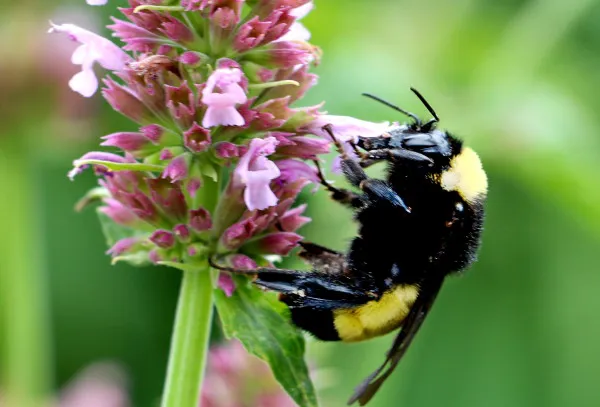Pollinator insects play a critical role in the agricultural world. Without their natural transference of pollen from plant to plant while obtaining nutrients, many types of vegetables and fruit for human consumption would not exist.

New Mexico State University’s Agricultural Science Center at Los Lunas is studying native plant garden mixes that attract pollinators and beneficial insects. (NMSU photo by Miranda Kersten)
More than 80 percent of plants are pollinated by animals, mainly insects. In recent years, there has been a decline in pollinator insects for many reasons, one being the decline or loss of habitat.
This is one area people can help support pollinator populations, by growing native flowering plants from which the pollinators obtain protein and lipids from the pollen, and carbohydrates and amino acids from the nectar.
Researchers at New Mexico State University’s College of Agricultural, Consumer and Environmental Sciences are studying the activity of insects, both pollinator and beneficial, around native plants to determine what mix of flowering cultivars will attract the different insect types.
“We have evaluated 22 different perennial native plants in seven different mixes, or combinations,” said Miranda Kersten, senior program specialist at NMSU’s Agricultural Science Center at Los Lunas, of the study that began in 2017. “For the last two summers, we have done visual observations where we record the number of different insect groups visiting the flower, and taken vacuum samples from each of the plots to see which species are attracted to the plants.”
From the current study, which is supported by a U.S. Department of Agriculture National Institute of Food and Agriculture Extension Implementation Program grant, the researchers can suggest plants to attract bumble bees, large and small native bees, and natural enemies of pests such as the ladybeetles, syrphid flies, and large and small wasps.
“The flowers range in color from various shades of purple and pink, to orange, yellow and white,” Kersten said. “We did not use red flowers because insects don’t see that color well and are less attracted to the blossoms.”
When planning a pollinator garden, it is important to include plants that flower at different times of the season.
“All during the season, bees are busy collecting nectar and pollen, depending if they are honey bees or native bees, to feed their babies during the winter,” said Amanda Skidmore, NMSU Cooperative Extension Service small farm integrated pest management specialist.
“Spring blooms help the early emerging pollinators,” she said. “Blooms throughout the summer that are different colors and shapes help attract the insects while they are building their nest. Fall blooms help them store up an energy source for their babies’ development.”
Bees are considered to be the most efficient pollinator. They are the only pollinator that feeds on pollen/nectar as larvae and adults.
“Some of our native bees are generalists, visiting many types of flowers, while others are specialists, visiting a specific species,” Skidmore said. “Bumblebees are generalists that are active from early spring to late fall, while different species of native bees are active in different times of the year.”
A little-known fact is that New Mexico has more than 1,000 unique native bee species – the third-highest number in the nation behind California and Arizona.
During the project, the researchers learned that Riddell’s ragwort was the latest-blooming flower of the plants included in the study and it was highly visited by bees and wasps in the fall.
Plants with extra-floral nectaries, such as Rocky Mountain penstemon, can provide additional resources through the growing season and benefit a variety of insects.
To learn more about identifying these beneficial insect groups, visit https://aces.nmsu.edu/pubs/_h/H172/welcome.html for the Extension publication “Backyard Beneficial Insects of New Mexico.”
